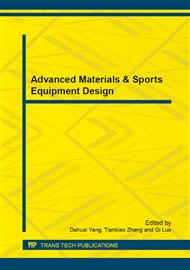[1]
J R Weertman. Hall-Petch strengthening in nanocrystalline metals[J]. Material Science & Engineering A, 1993, 166: 161-167.
DOI: 10.1016/0921-5093(93)90319-a
Google Scholar
[2]
Valiev. R. Z, Islamgaliev .R. K, and Alexandrov I. V. Bulk nanostructured materials from severe plastic deformation[J]. Progress in Materials Science. 2000, Vol. 45: 103-189.
DOI: 10.1016/s0079-6425(99)00007-9
Google Scholar
[3]
H Gleiter. Nanocrystalline materials[J]. Progress in Materials Science, 1989, 33: 223-315.
Google Scholar
[4]
R ZValiev, Y V Ivanisenko, E F Rauch, et a1. Structure and deformaton behaviour of Armco iron subjected to severe plastic deformation[J]. Acta Materialia, 1996, 44: 4705-4712.
DOI: 10.1016/s1359-6454(96)00156-5
Google Scholar
[5]
R.Z. Valiev1, E.V. Kozlov, Yu.F. Ivanov, et al. Deformation behaviour of ultra-fine-grained copper. Acta Metallurgica et Materialia, 1994, Vol. 42(7): 2467-2475.
DOI: 10.1016/0956-7151(94)90326-3
Google Scholar
[6]
Christopher S. Meredith, Akhtar S. Khan. Texture evolution and anisotropy in the thermo-mechanical response of UFG Ti processed via equal channel angular pressing[J]. International Journal of Plasticity, 2012, Vol. 30-31: 202-217.
DOI: 10.1016/j.ijplas.2011.10.006
Google Scholar
[7]
Y T Zhu, T C Lowe, T G Langdon. Performance and applications of nanostructured materials produced by severe plastic deformation[J]. Scripta Materialia, 2004, 51: 825-830.
DOI: 10.1016/j.scriptamat.2004.05.006
Google Scholar
[8]
Z Horita, T Fujinami, T G Langdor. The potential for scaling ECAP: effect of sample size on grain refinement and mechanical properties[J]. Materials Science & Engineering A, 2001, 318: 34-41.
DOI: 10.1016/s0921-5093(01)01339-9
Google Scholar
[9]
M Furukawa, Y Iwahashi, Z Horita, et al. The shearing characteristics associated with equal-channel angular pressing[J]. Material Science& Engineering A, 1998, 257: 328-332.
DOI: 10.1016/s0921-5093(98)00750-3
Google Scholar
[10]
M Furukawa, Z Horita, T G Langdom. Factors influencing the shearing patterns in equal-channel angular pressing[J]. Material Science & Engineering A, 2002, 332: 97-109.
DOI: 10.1016/s0921-5093(01)01716-6
Google Scholar
[11]
R K Oruganti, P R Subramanian, J S Matte, et al. Effect of friction, backpressure and strain rate sensitivity on material flow during equal channel angular extrusion[J]. Material Science & Engineering A, 2005, 406: 102-109.
DOI: 10.1016/j.msea.2005.06.031
Google Scholar
[12]
K Nakashima, Z Horita, M Nemoto, et al. Development of a multi-pass facility for equal-channel angular pressing to high total strains[J]. Materials Science & Engineering A, 2000, 281: 82-87.
DOI: 10.1016/s0921-5093(99)00744-3
Google Scholar
[13]
A Ma, Y Nishida, K Suzuki, et al. Characteristics of plastic deformation by rotary-die equal-channel angular pressing[J]. Scripta Materialia, 2005, 52: 433-437.
DOI: 10.1016/j.scriptamat.2004.11.014
Google Scholar
[14]
A. V. Korznikov, Yu V. Ivanisenko, D. V. Laptionok, I. M. Safarov, et al. Influence of severe plastic deformation on structure and phase composition of carbon steel[J]. Nanostructured Materials. 2007, Vol. 4: 159-167.
DOI: 10.1016/0965-9773(94)90075-2
Google Scholar
[15]
Yoshinori Iwahashi, Zenji Horita, Minoru Nemoto, et al. The process of grain refinement in equal-channel angular pressing[J]. Acta Materialia, 1998, Vol. 46: 3317-3331.
DOI: 10.1016/s1359-6454(97)00494-1
Google Scholar


